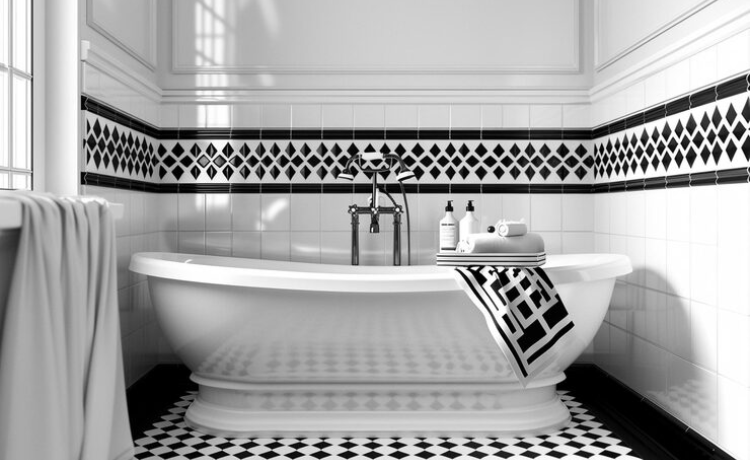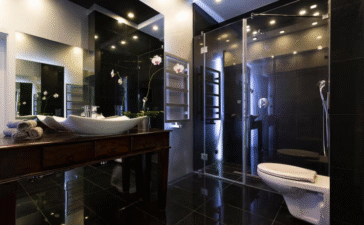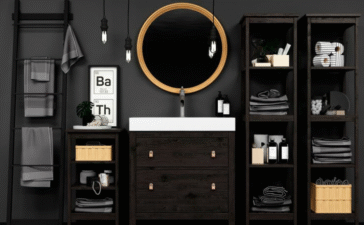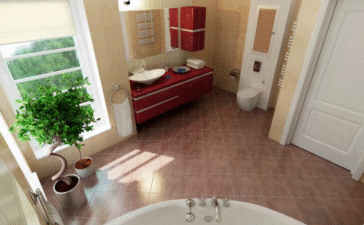Your bathroom deserves more than just functional fixtures; it should be a sanctuary that reflects your personal style while standing up to daily use. The right tile selection can transform an ordinary bathroom into a luxurious retreat, combining aesthetic appeal with practical durability. Whether you’re planning a complete renovation or simply updating your space, understanding current trends, materials, and installation techniques will help you make informed decisions that enhance both the value and enjoyment of your home. This comprehensive guide explores everything you need to know about bathroom tile designs, from the hottest trends of 2025 to practical considerations for installation and maintenance. You’ll discover how different materials perform in wet environments, learn about cost-effective approaches to renovation, and gain insights into professional design techniques that create stunning visual impact.
The bathroom tile market has evolved dramatically, offering homeowners unprecedented choices in style, material, and functionality. Recent industry data shows that bathroom renovations consistently rank among the top home improvement projects, with tile selection being the most critical decision affecting both aesthetics and long-term satisfaction.
Trending Bathroom Tile Designs in 2025
The world of bathroom tile design continues to evolve, with 2025 bringing fresh interpretations of classic styles alongside innovative new approaches. Understanding these trends helps you create a space that feels current while maintaining timeless appeal.
Subway Tiles: Reinventing a Classic
Subway tiles remain a cornerstone of bathroom design, but contemporary applications have breathed new life into this traditional format. Modern installations feature varied orientations, oversized versions, and unexpected color palettes. The classic 3×6 inch format now shares space with 4×8 and 6×12 variations, allowing for more dramatic visual impact. Color trends have expanded beyond crisp white to include soft grays, sage greens, and warm off-whites that complement natural lighting.
The versatility of subway tiles makes them suitable for both traditional and contemporary bathrooms. Stacking patterns create clean, modern lines, while traditional brick patterns offer timeless charm. Edge treatments have also evolved, with beveled edges adding subtle dimension and handmade variations introducing organic texture.
Herringbone Patterns: Dynamic Visual Interest
Herringbone patterns have gained tremendous popularity for their ability to add movement and sophistication to bathroom spaces. This classic pattern works exceptionally well with rectangular tiles, creating zigzag designs that draw the eye and make spaces appear larger. The pattern works equally well on floors and walls, with many designers incorporating it as an accent feature behind vanities or in shower niches.
Contemporary herringbone applications often feature contrasting grout colors to emphasize the pattern, while monochromatic approaches create subtle texture without overwhelming smaller spaces. The pattern’s versatility allows it to complement both modern and traditional design aesthetics.
Mosaic Tiles: Intricate Artistry
Mosaic tiles offer unparalleled opportunities for creative expression, allowing homeowners to incorporate intricate patterns, color gradients, and artistic focal points. Modern mosaic applications range from subtle tone-on-tone patterns to bold geometric designs that serve as bathroom artwork.
Glass mosaics remain popular for their light-reflecting properties, which can make small bathrooms feel more spacious and bright. Natural stone mosaics add texture and organic appeal, while porcelain mosaics offer durability with unlimited design possibilities. The key to successful mosaic installation lies in careful planning and professional execution to ensure proper alignment and consistent spacing.
Terrazzo Tiles: Sustainable Luxury
The resurgence of terrazzo reflects growing interest in sustainable design and artisanal craftsmanship. Modern terrazzo tiles combine recycled materials with contemporary manufacturing techniques, resulting in surfaces that are both environmentally responsible and visually striking. The speckled appearance of terrazzo adds visual interest while hiding minor imperfections and water spots.
Contemporary terrazzo extends beyond traditional gray bases to include vibrant colors and oversized aggregate pieces that create bold, artistic statements. The material’s durability makes it particularly suitable for high-traffic bathrooms, while its unique patterns ensure that no two installations look identical.
Large Format Tiles: Seamless Sophistication
Large format tiles continue to dominate contemporary bathroom design, with sizes ranging from 12×24 inches to dramatic 24×48 inch panels. These oversized tiles create seamless surfaces with minimal grout lines, contributing to clean, uncluttered aesthetics that make spaces appear larger and more sophisticated.
The reduced number of grout lines not only enhances visual appeal but also simplifies maintenance, as there are fewer areas where dirt and moisture can accumulate. Large format tiles work particularly well in modern and minimalist designs, though they can also be incorporated into traditional spaces for a fresh, updated look.
Textured Tiles: Tactile Dimension
Textured tiles add depth and visual interest to bathroom surfaces, creating focal points that engage multiple senses. Three-dimensional patterns, wave designs, and geometric textures transform flat surfaces into dynamic architectural elements. These tiles work particularly well as accent features, such as behind freestanding tubs or on single accent walls.
The interplay of light and shadow across textured surfaces changes throughout the day, creating dynamic visual experiences that keep bathroom spaces interesting and engaging. Proper lighting design becomes crucial when incorporating textured tiles to maximize their visual impact.
Understanding Bathroom Tile Materials
Material selection forms the foundation of successful bathroom tile installation, affecting everything from durability and maintenance to aesthetic appeal and cost. Each material brings unique characteristics that make it more or less suitable for specific applications and design goals.
Ceramic and Porcelain Tiles: The Practical Choice
Ceramic and porcelain tiles represent the most popular choices for bathroom applications, offering excellent water resistance, durability, and value. Porcelain tiles, being denser and less porous than ceramic, provide superior water resistance and are suitable for both floor and wall applications. Recent advances in manufacturing have produced porcelain tiles that convincingly mimic natural materials like wood, stone, and concrete.
The glazing process applied to ceramic tiles creates water-resistant surfaces perfect for shower surrounds and wet areas. Modern ceramic tiles feature improved slip resistance ratings, making them safer for bathroom floors. Both materials accept a wide range of colors, patterns, and finishes, providing extensive design flexibility at accessible price points.
Natural Stone Tiles: Timeless Elegance
Natural stone tiles bring unmatched luxury and unique character to bathroom spaces. Marble remains the gold standard for elegant bathroom design, offering beautiful veining patterns and cool surfaces that feel luxurious underfoot. However, marble requires regular sealing and careful maintenance to prevent etching from acidic cleaners.
Granite provides exceptional durability and stain resistance while offering a wide range of colors and patterns. Travertine contributes warm, earthy tones and natural texture but requires more maintenance than other stone options. Each piece of natural stone is unique, ensuring that no two installations are identical.
Glass Tiles: Light and Reflection
Glass tiles excel at reflecting light and creating bright, airy bathroom environments. They work particularly well in smaller bathrooms where their reflective properties can make spaces feel larger and more open. Glass tiles are non-porous, making them highly resistant to stains, mold, and mildew.
The manufacturing process for glass tiles has advanced significantly, producing options that range from clear and frosted to opaque and metallic. Recycled glass tiles support sustainable design goals while providing unique color variations and environmental benefits.
Terracotta Tiles: Rustic Warmth
Terracotta tiles introduce warm, earthy tones that create cozy, inviting bathroom atmospheres. The natural clay composition provides unique color variations and organic texture that complement rustic, Mediterranean, and bohemian design styles. Modern terracotta tiles feature improved glazing and sealing techniques that enhance water resistance while maintaining their natural charm.
The thermal properties of terracotta make it comfortable for barefoot contact, while its natural variations ensure that each installation has a unique character. Proper sealing is essential for bathroom applications to prevent water absorption and staining.
Eco-Friendly Tiles: Sustainable Innovation
Sustainable tile manufacturing has advanced dramatically, offering environmentally responsible options without compromising style or performance. Recycled content tiles incorporate post-consumer materials, while locally sourced options reduce transportation environmental impact.
Bio-based tiles use renewable materials in their composition, while energy-efficient manufacturing processes reduce carbon footprints. Many eco-friendly tiles carry certifications from recognized environmental organizations, helping homeowners make informed choices about their environmental impact.
Practical Considerations When Choosing Tiles
Successful tile selection requires balancing aesthetic preferences with practical performance requirements. Understanding how different factors affect both immediate installation and long-term satisfaction ensures that your investment delivers lasting value.
Tile Size Selection Strategy
Tile size significantly impacts both the visual appearance and practical aspects of your bathroom. Larger tiles can make small bathrooms appear more spacious by reducing the number of grout lines, while smaller tiles provide better slip resistance on floors due to increased grout line frequency.
Consider the proportions of your bathroom when selecting tile sizes. Very large tiles in tiny spaces can appear overwhelming, while very small tiles in large spaces may create busy, fragmented appearances. Medium-sized tiles often provide the best balance for average bathroom dimensions.
Grout Color Impact
Grout color selection can dramatically alter the final appearance of your tile installation. Matching grout colors to tile colors creates seamless, continuous surfaces that emphasize tile patterns and colors. Contrasting grout colors highlight individual tiles and geometric patterns, creating more dynamic visual effects.
Light-colored grouts show dirt and staining more readily than darker alternatives, requiring more frequent cleaning and maintenance. However, very dark grouts can make spaces feel smaller and may show soap residue and calcium deposits from hard water.
Water and Slip Resistance Requirements
Safety and durability requirements vary significantly between different bathroom areas. Shower floors require tiles with excellent slip resistance and minimal water absorption, while decorative wall areas have different performance requirements.
Look for tiles with appropriate slip resistance ratings for their intended use. The American National Standards Institute provides standardized testing methods for slip resistance, helping you select tiles that meet safety requirements for specific applications.
Maintenance Considerations
Different tile materials require varying levels of maintenance to maintain their appearance and performance. Natural stone tiles typically require periodic sealing and pH-neutral cleaners, while porcelain tiles need minimal special care.
Consider your willingness and ability to perform ongoing maintenance when selecting tile materials. High-maintenance materials may not be suitable for busy households or rental properties where maintenance may be neglected.
Design Styles and Selection Guidance
Understanding how different tile choices support various design aesthetics helps you create cohesive, intentional bathroom spaces that reflect your personal style while maintaining broad appeal.
Modern Minimalism: Clean Sophistication
Modern minimalist bathrooms emphasize clean lines, neutral colors, and uncluttered surfaces. Large format tiles in whites, grays, and subtle earth tones support this aesthetic by creating seamless backgrounds that highlight architectural features and fixtures.
Geometric patterns and monochromatic color schemes reinforce minimalist principles, while high-quality materials like large-format porcelain or natural stone provide subtle luxury without visual complexity. The key lies in restraint and careful attention to proportion and detail.
Traditional Elegance: Timeless Appeal
Traditional bathroom designs often incorporate classic materials and patterns that have proven their appeal over decades. Subway tiles, hexagonal floor patterns, and natural stone materials support traditional aesthetics while providing contemporary performance.
Warm colors, detailed patterns, and mixed materials create layered, sophisticated appearances that feel both comfortable and refined. Traditional designs often incorporate contrasting elements, such as decorative borders or accent tiles, to add visual interest and craftsmanship details.
Rustic Charm: Natural Warmth
Rustic bathroom designs celebrate natural materials, organic textures, and warm color palettes. Wood-look tiles, natural stone, and terracotta create authentic rustic atmospheres while providing modern durability and water resistance.
Handmade tiles with slight irregularities and natural color variations enhance the authentic feel of rustic designs. Mixing different natural materials and incorporating reclaimed elements supports the sustainable, connected-to-nature philosophy of rustic design.
Industrial Style: Urban Edge
Industrial bathroom designs incorporate concrete-look tiles, metallic accents, and exposed structural elements. Large format tiles in gray tones, paired with metal fixtures and minimal color palettes, create sophisticated urban aesthetics.
Textured tiles that mimic concrete, brick, or metal surfaces support industrial themes while providing practical bathroom performance. The key lies in balancing raw, industrial elements with comfortable, livable details.
Bohemian Vibes: Creative Expression
Bohemian bathroom designs celebrate color, pattern, and artistic expression. Mosaic tiles, bold patterns, and unexpected color combinations create personalized spaces that reflect individual creativity and cultural influences.
Mixing different tile patterns, sizes, and colors requires careful planning to achieve harmonious rather than chaotic results. Successful bohemian designs often incorporate a unifying element, such as a consistent color thread or material family, to maintain visual coherence.
Budgeting for Bathroom Tile Designs
Understanding the true costs associated with tile selection and installation helps you make informed decisions that balance quality, aesthetics, and financial considerations.
Material Cost Considerations
Tile material costs vary dramatically based on type, quality, and source. Basic ceramic tiles may cost as little as $1-3 per square foot, while premium natural stone options can exceed $15-20 per square foot. Porcelain tiles typically fall in the $3-8 per square foot range, offering good value for most applications.
Remember that material costs represent only part of your total investment. Installation labor, substrate preparation, and finishing materials add significantly to project costs. Premium materials may require specialized installation techniques that increase labor costs.
Installation Investment Analysis
Professional tile installation typically costs $5-15 per square foot, depending on complexity, location, and installer experience. Simple installations on prepared surfaces cost less than complex patterns requiring extensive cutting and fitting.
DIY installation can reduce costs significantly but requires considerable time, skill, and proper tools. Mistakes in DIY installations can be expensive to correct and may void material warranties. Consider your skill level honestly when deciding between professional and DIY installation.
Cost Optimization Strategies
Several strategies can help optimize your tile budget without compromising quality or aesthetics. Using premium tiles in focal areas while selecting more affordable options for less visible areas can create high-impact results within budget constraints.
Shopping during promotional periods, considering discontinued or overstock materials, and working with local suppliers can provide cost savings. However, ensure that you can obtain sufficient quantities to complete your project when selecting discounted materials.
Installation Tips for Bathroom Tiles
Proper installation techniques ensure that your tile investment provides years of beautiful, trouble-free service. Understanding key installation principles helps you work effectively with contractors or tackle DIY projects successfully.
Layout Planning Excellence
Successful tile installation begins with careful layout planning that considers the visual impact of tile placement, pattern alignment, and edge treatments. Starting with accurate room measurements and creating detailed layout drawings prevents costly mistakes and ensures professional results.
Consider how tile patterns will interact with bathroom fixtures, corners, and transitions to other flooring materials. Plan cut tile locations to minimize waste and ensure that cut tiles appear in less visible locations. Symmetrical layouts generally provide more pleasing visual results than asymmetrical arrangements.
Substrate Preparation Requirements
Proper substrate preparation forms the foundation for successful tile installation. Surfaces must be clean, level, and structurally sound to support tile weight and prevent future problems. Waterproof membranes are essential in wet areas to prevent moisture damage to underlying structures.
Address any structural issues, such as squeaky floors or loose wall surfaces, before beginning tile installation. Proper substrate preparation may require additional time and expense but prevents far more costly problems later.
Cutting and Fitting Techniques
Accurate tile cutting requires proper tools and techniques to achieve professional results. Wet saws provide the cleanest cuts for most tile materials, while specialized tools may be required for natural stone or glass tiles.
Plan cuts carefully to minimize waste and ensure proper fit around fixtures and in corners. Test cuts on spare tiles to verify technique before cutting final pieces. Proper safety equipment, including eye and hearing protection, is essential when cutting tiles.
Adhesive Selection and Application
Selecting appropriate tile adhesives ensures strong, durable bonds that resist moisture and temperature changes. Different tile materials and substrates require specific adhesive formulations for optimal performance.
Apply adhesives evenly using appropriate trowel sizes to ensure complete tile contact and prevent hollow spots that can lead to cracking. Work in manageable sections to prevent adhesive skinning before tile placement.
Sealing and Protection
Proper sealing protects both tiles and grout from moisture, stains, and wear. Natural stone tiles typically require sealing before grouting to prevent grout staining, while all grout joints benefit from quality sealers.
Apply sealers according to manufacturer instructions and maintain them through periodic reapplication. Quality sealers provide long-term protection that preserves both appearance and performance.
Visual Inspiration and Planning Tools
Modern technology provides numerous tools for visualizing and planning bathroom tile installations, helping you make confident decisions before beginning construction.
Digital Visualization Resources
Online visualization tools allow you to experiment with different tile combinations, patterns, and colors in virtual bathroom environments. Many tile manufacturers provide sophisticated design tools that help you see how their products will look in realistic settings.
Mobile apps provide convenient access to design tools and allow you to capture inspiration photos during shopping trips. Some apps can even estimate material quantities based on room dimensions and selected tile sizes.
Creating Effective Mood Boards
Mood boards help organize your design ideas and communicate your vision to contractors and suppliers. Include samples of tiles, grout colors, fixtures, and paint colors to see how all elements work together.
Physical mood boards using actual material samples provide more accurate color representation than digital versions. Create multiple mood boards to explore different design directions before making final selections.
Professional Design Consultation
Working with experienced bathroom designers or tile specialists can provide valuable insights and prevent costly mistakes. Professionals understand how different materials perform in bathroom environments and can suggest alternatives that meet both aesthetic and practical requirements.
Design consultations may include space planning, material selection guidance, and detailed installation specifications. The investment in professional design services often pays for itself through improved results and avoided mistakes.
Frequently Asked Questions
What are the best tile options for small bathrooms?
Small bathrooms benefit from light-colored tiles that reflect light and make spaces appear larger. Large format tiles with minimal grout lines create seamless surfaces that don’t visually fragment small spaces. Glossy finishes enhance light reflection, while vertical tile patterns can make ceilings appear higher. Avoid busy patterns or very small tiles that can make compact spaces feel cluttered.
How do I maintain my bathroom tiles properly?
Regular cleaning with appropriate cleaners maintains tile appearance and prevents damage. Use pH-neutral cleaners for natural stone tiles and avoid abrasive cleaners that can damage glazed surfaces. Clean grout lines regularly to prevent discoloration and reapply sealers as recommended by manufacturers. Address stains and damage promptly to prevent permanent problems.
Can I mix different tile styles in one bathroom?
Mixing different tile styles can create visual interest and define different areas within bathrooms. Successful mixing requires careful attention to color coordination, scale relationships, and style compatibility. Use one tile type as the dominant element and introduce contrasting tiles as accents to maintain visual coherence. Consider consulting with design professionals for complex mixing schemes.
What is the best tile for shower walls?
Shower walls require tiles with excellent water resistance and easy cleaning properties. Porcelain and glazed ceramic tiles perform well in shower environments, while natural stone tiles require proper sealing and maintenance. Glass tiles provide excellent water resistance and easy cleaning, while large format tiles minimize grout lines where moisture can accumulate.
Are there eco-friendly tile options available?
Numerous eco-friendly tile options support sustainable design goals. Recycled content tiles incorporate post-consumer materials, while locally manufactured tiles reduce transportation environmental impact. Natural materials like terracotta and stone can be environmentally responsible choices when sourced locally. Look for tiles with third-party environmental certifications to verify sustainability claims.
How long does tile installation typically take?
Installation timeframes depend on project scope, complexity, and installer experience. Simple bathroom tile installations may take 3-5 days, while complex projects requiring extensive substrate preparation or intricate patterns may take 1-2 weeks. Allow additional time for adhesive and grout curing before using newly tiled areas.
What thickness of tile should I choose for bathroom floors?
Floor tiles should be at least 3/8 inch thick for residential bathroom applications to provide adequate strength and durability. Thicker tiles offer better sound dampening and feel more substantial underfoot. However, very thick tiles may create height transition issues with adjacent flooring materials that require careful planning.
How do I choose the right grout color?
Grout color significantly affects the overall appearance of tile installations. Matching grout to tile color creates seamless, continuous surfaces that emphasize tile patterns and colors. Contrasting grout highlights individual tiles and geometric patterns for more dynamic effects. Consider maintenance requirements when selecting grout colors, as light colors show dirt more readily than darker alternatives.
You would also like: “bathroom floor ideas“
Creating Your Perfect Bathroom Sanctuary
Transforming your bathroom through thoughtful tile selection represents one of the most impactful improvements you can make to your home. The combination of aesthetic appeal, functional performance, and long-term value makes quality tile installation an investment that pays dividends for years to come. From trending designs that reflect contemporary style to time-tested materials that provide lasting beauty, the options available today offer unprecedented opportunities to create truly personalized spaces.
Success in bathroom tile design comes from balancing multiple considerations: understanding how different materials perform in wet environments, selecting patterns and colors that complement your overall design vision, and ensuring proper installation techniques that protect your investment. Whether you choose the clean sophistication of large format porcelain, the timeless appeal of natural stone, or the artistic expression of custom mosaics, the key lies in making informed decisions that align with both your immediate needs and long-term goals.
Take time to explore your options thoroughly, consult with experienced professionals when needed, and don’t rush the decision-making process. Your bathroom renovation represents a significant investment in both comfort and home value, deserving careful planning and quality execution. With proper planning and professional installation, your new bathroom tiles will provide daily enjoyment and lasting satisfaction for years to come.












